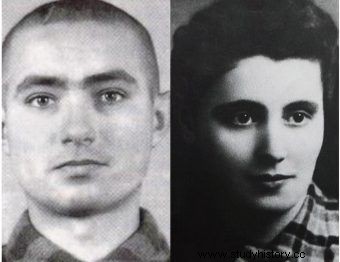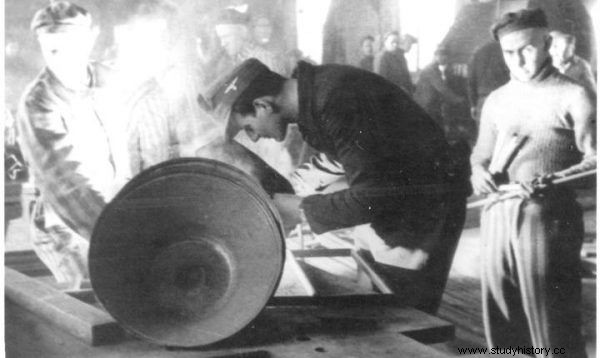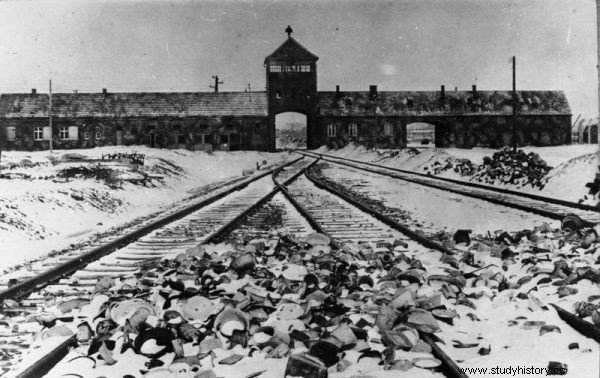Even in inhuman times, love brings comfort and hope. This was the case with a prison couple who decided to flee the place of execution together. Even ... an SS man came to their aid!
The great love of Edward Galiński and Mala Zimetbaum can be compared to Shakespeare's drama. Their escape from the concentration camp became a camp legend. Unfortunately, the ending also strongly resembles the tragedies in the spirit of Shakespeare ...
They met in Auschwitz
Mala was a Belgian Jewish woman of Polish descent. Due to her father's illness, she quickly started working at the famous fashion house Maison Lilian. She was arrested by the Gestapo during a round-up at the Antwerp station in 1942. After a few months, she was transported to Auschwitz.

The love of Mala and Edek is reminiscent of Shakespeare's drama…
The woman was very well remembered by her fellow prisoners, even though many of them could envy her. She was beautiful, knew several languages (German, French, Dutch, Italian and Polish and a bit of Russian), so she quickly became a camp translator and found herself in the elite . She worked in the office but treated other prisoners very kindly. She was cheerful and strangely reconciled with her fate. One of her fellow prisoners was consoled:
Do not worry, do not be afraid, who will live this life, and who will not, you can see - there should not be a strange death for us here.

Mala was very much liked by her fellow prisoners.
She helped others if she could. For Zofia Bator, she stole a photo of her tiny nephews, Maria Kulce - so as not to disfigure her - she tattooed a tiny number, which the woman remembered for a long time. She taught her fellow prisoners French songs and helped to write letters to their families.
Edward Galiński was sent to the camp in June 1940. He was 17 years old then and was arrested as part of the AB operation, the purpose of which was to fight the Polish intelligentsia. He had to change from boy to man very quickly. He started working in a locksmith shop where he met Edward Lubusch, to whom we will return soon.
There was love in Auschwitz
Mala and Edek met at the turn of 1943 and 1944. "I love and I am loved" - confided Mala Annie Palarczyk, one of her trusted fellow prisoners. It would seem that love in such conditions is not possible at all, and yet it flourished amid death, pain and smoke from the crematorium furnaces.
In love, they were looking for crumbs of normalcy in Hell. There is a story when Mala asked a prisoner, Zofia Bator, to paint a portrait that she could give to her beloved:
It was my happiest time, the happiest hours as I sat in this quiet room, when there were no prisoners next to me, this perpetual murmur of conversations of several hundred people. After graduating, Mala said that she liked the portrait very much. She was really grateful to me. She had a party. Sandwiches smeared with margarine. It was a royal party.
Edek also talked about his feelings for Mali. His confidant was a friend, Wiesław Kielar, with whom he initially planned to escape from the camp:
However, it was clear that Edek is the object of boundless love on the part of Mali. It is not surprising, because he was extremely handsome, very masculine, courageous, prone to risk. In the camp, he developed from a boy to a man.

Edek Galiński quickly had to change from a boy to a man
Years later, the friend also revealed more intimate details of the developing relationship:
They wanted each other. Maybe I shouldn't say it because I haven't even covered it in my book, but I think it's been so long and my mouth will close too soon. And let there be this piece of truth as well. Usually it happened in a place that any SS-man would least expect. In block 30, in the so-called x-ray room, where Dr. Mengele and Schumann x-rayed women and men previously selected for the experiments. This was what the table was for. It was used to kill, to sterilize prisoners, and it also served as a bed of love for these two.
The love story was touching and unbelievable. Wiesław was so touched by her that he decided to "give up" his place in the escape plan for his beloved Edek.
A good SS man helps you escape
One of the SS men - Edward Lubush - helped in the escape of the couple in love. This young boy, coming from a Polish-German family, maintained his humanity in absolutely inhuman times. Although he volunteered to Auschwitz (he did not know what concentration camps really were at the time), he did not participate in the bestialities typical of the guards, and was punished many times for his gentleness. His attitude saved many prisoners. This was due to the workshop he ran, in which the exhausted and sick regained their strength.
One of the prisoners said about him:
I met Lubusch as a blockführer. He was too gentle, so he did not stay in this position for a long time. He even collided with the authorities, and as a result he was sent to (...) Stutthof for a few months. In a special prison camp for the SS, he was to be taught the proper treatment of prisoners. (…) The effect was just the opposite. Not only did he not change in relation to the prisoners, but he was even more friendly to them. But he was now more careful and disguised himself better.

Edek made friends with SS officer Lubusch while working in the locksmith shop
Edward befriended many prisoners, incl. with Stanisław Trynek, to whom he once confessed in an interview:“Staś! If we start a cast iron foundry, I can get promoted. I really shit on this promotion. Thanks to it I will be able to avoid going to the front ”And the hero of our story, Edek Galiński.
As Przemysław Semczuk, who discovered this amazing story, relates:
The plan was simple. Edek, dressed in an SS uniform, was to lead the prisoner outside the camp. Further, in the village of Kozy, Antoni Szymalak was to help them. The uniform was provided by Lubusch. Probably his own, because with the insignia of the SS-Rottenführer. He also donated a pistol with three rounds. The escape was successful.
The lovers escaped from the camp on June 24, 1944. After crossing the gates, Mala threw off her striped uniform, under which she was wearing a dress. They looked like a couple in love - the SS man and his girlfriend.
Tragic setback
After its initial success, the story took a tragic turn. Mala came across a German patrol in the shop and was arrested. Edek then decided to come out of hiding. They were recognized as prisoners of Auschwitz and sent back to the camp. The lovers ended up in Block 11 - more commonly known as the Death Block and imprisoned in separate cells. Joanna Bator recalled:
When we found out that they had been captured, that Mala was sitting in the bunker - the death block, despair fell on the whole camp.
They were both subjected to cruel tortures, but they did not release Edward Lubusch. Edek made sure that the SS man received a secret message confirming that the guard was safe. At night, the boy sang or whistled, thus signaling his beloved that he was alive. Both were soon sentenced to death.
Edek's execution was quite dramatic. Wiesław Kielar reported:
He climbed onto a stool. The judgment began to be read in German and Polish. Before it was finished, Galiński put his head in the noose and bounced off the stool. Immediately a lagerkapo Jup ran up to him and released him from the loop, putting a stool under his feet. And the sentence was read again. The last words had not faded away yet, when Galiński began to shout:"Yet Pol ..." - but this "Poland" got stuck in his throat Jup tore up the stool and there was silence.
The nervous SS man tried to chase the prisoners away. Everyone took their hats off…

Edek and Mala's love story ended tragically
Mala died at the same time. Her execution was even more dramatic. The woman tried to slit her veins with a tiny razor blade. However, she was stopped and brutally kicked by the guards. When the blade was taken from her, she hit the guard in the face and shouted, "I will die a heroine, you will die like a dog!" The bestial camp director decided that Mala should be burnt alive in the crematorium furnace. The nurses bandaged the woman's hands extremely slowly, hoping that she would bleed out before going to the furnace alive. The semiconscious Mala was transported in a wheelbarrow to the crematorium.
It is not known what the end of this terrible execution really was. According to some prisoners, one of the SS men shortened her suffering with a shot to the head, others claim that she ended up in the fire alive.
A memento of this great, tragic love are locks of hair wrapped in paper, which are still kept in the Auschwitz Museum to this day.
